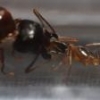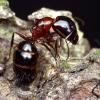- Formiculture.com
- Forums
- Gallery
- Members
- Member Map
- Chat

Queen ant
Started By
Will230145
, Feb 9 2018 7:07 PM

Best Answer Will230145 , February 9 2018 - 7:43 PM
YAAAAAAY! THIS IS MY DREAM SPECIES!!! Is there a care sheet on them?
Go to the full post 
34 replies to this topic
#21
 Offline
-
Posted February 10 2018 - 8:26 AM
Offline
-
Posted February 10 2018 - 8:26 AM
1. Location (on a map) of collection: western Pennsylvania (grove City) US
2. Date of collection: August 29 2017
3. Habitat of collection: in the grass
4. Length (from head to gaster): 9mm
5. Color, hue, pattern and texture: light brown with “yellowish” legs
6. Distinguishing characteristics: quite calm and shy
7. Distinguishing behavior: shy, always awake, and does not mind the light
8. Nest description: the colony I found her fly from was under a stone and looked light brown with a shiny pubescence
9. Nuptial flight time and date: August 29 2017, around 12:00pm
2. Date of collection: August 29 2017
3. Habitat of collection: in the grass
4. Length (from head to gaster): 9mm
5. Color, hue, pattern and texture: light brown with “yellowish” legs
6. Distinguishing characteristics: quite calm and shy
7. Distinguishing behavior: shy, always awake, and does not mind the light
8. Nest description: the colony I found her fly from was under a stone and looked light brown with a shiny pubescence
9. Nuptial flight time and date: August 29 2017, around 12:00pm
#22
 Offline
-
Posted February 10 2018 - 9:53 AM
Offline
-
Posted February 10 2018 - 9:53 AM
Do flavus wait before or after hibernation to lay? Mine waited after hibernation too lay eggs
In most cases, both Lasius flavus and Lasius neoniger (and other related species in temperate regions) tend to wait until after hibernation to lay eggs.
Most ants that fly later in the year wait until spring to lay.
- noebl1 likes this
#23
 Offline
-
Posted February 10 2018 - 10:49 AM
Offline
-
Posted February 10 2018 - 10:49 AM
2. Date of collection: August 29 2017
8. Nest description: the colony I found her fly from was under a stone and looked light brown with a shiny pubescence
So a couple comments here; If you caught her directly as she flew out from under a stone, she may not have had a chance to mate, so may not be fertile (though I could be misreading #8.) Also L. neoniger tends to fly from small "volcano" like sand or dirt hills in the flights I've observed. It's not impossible from under a rock I guess as they will occasionally clear out cracks (like between bricks or driveway cracks) from what I've also observed. L. alienus and the L. flavus group tend to fly from under rocks or literally appear from no where from holes in the ground (as they aren't often seen at the surface like L. neoniger.
I did find this from @batspiderfish on Ants Canada forum:
"Lasius alienus will fly July through August. Lasius neoniger, Lasius pallitarsis, Lasius flavus, and Lasius nearcticus will fly August through September and October."
Here's another helpful thread @batspiderfish posted to help ID:
http://forum.antscan...php?f=48&t=2421
Again, pretty much impossible to ID without super clear shots of the head of the mandibles and antenna.
Edited by noebl1, February 10 2018 - 10:50 AM.
#24
 Offline
-
Posted February 10 2018 - 11:33 AM
Offline
-
Posted February 10 2018 - 11:33 AM
I saw her mate as well, and the colony was under a rock but was having nuptial flight on top of the rock
I tried as best as I could... https://imgur.com/gallery/Bnu2S
I tried as best as I could... https://imgur.com/gallery/Bnu2S
Edited by Will230145, February 10 2018 - 11:36 AM.
#25
 Offline
-
Posted February 10 2018 - 11:44 AM
Offline
-
Posted February 10 2018 - 11:44 AM
I caught my Lasius alienus queen in mid July so i think august may be too late idk
#26
 Offline
-
Posted February 10 2018 - 11:47 AM
Offline
-
Posted February 10 2018 - 11:47 AM
Lasius alienus have nuptial flights a few months earlier than Neoniger and flavus
#27
 Offline
-
Posted February 10 2018 - 12:19 PM
Offline
-
Posted February 10 2018 - 12:19 PM
I caught 10 Lasius alienus queens that Batspiderfish identified for me, on August 3rd. By August 13th, all of them had lain a small batch of eggs. But the thing was, the eggs weren’t developing. According to Brian L. Fisher, the myrmecologist who created AntWeb, ants in the San Francisco Bay Area where him and I reside, do not hibernate in winter months as the weather is not cold enough for them to truly hibernate. I didn’t hibernate my Lasius alienus queens, and now all of them have larvae. My theory is that although it doesn’t get cold enough for them to truly hibernate, it still gets cool enough for foraging and egg laying to slow down a little bit. Idk I just thought this was interesting.
Edited by Jadeninja9, February 10 2018 - 12:21 PM.
#28
 Offline
-
Posted February 10 2018 - 12:20 PM
Offline
-
Posted February 10 2018 - 12:20 PM
Do you think mine is Lasius alienus?
#29
 Offline
-
Posted February 10 2018 - 12:21 PM
Offline
-
Posted February 10 2018 - 12:21 PM
Mine don’t have bloaded gasters like yoursDo you think mine is Lasius alienus?
#30
 Offline
-
Posted February 10 2018 - 12:25 PM
Offline
-
Posted February 10 2018 - 12:25 PM
Did they have bloated gasters while laying eggs? I also only have one Queen of whatever this queen is 
#31
 Offline
-
Posted February 10 2018 - 12:35 PM
Offline
-
Posted February 10 2018 - 12:35 PM
Did they have bloated gasters while laying eggs? I also only have one Queen of whatever this queen is
Nope they never had bloated gasters
#32
 Offline
-
Posted February 10 2018 - 12:36 PM
Offline
-
Posted February 10 2018 - 12:36 PM
Ok, thanks! I don’t think she is alienus.
#33
 Offline
-
Posted February 10 2018 - 12:46 PM
Offline
-
Posted February 10 2018 - 12:46 PM
I doubt she is L. alienus based on when you caught it. I've caught a few L. alienus over the last couple years, and find they tend to fly (here) around sunset, and often catch them at night attracted to lights. They also seem to fly in July to very early August, and overall they are slightly smaller (especially the gaster) and darker than other Lasius I have caught in the Fall. Again this isn't necessary a perfect way to ID as not sure if this is universal for every location. My L. alienus have also laid eggs and had nanitics in the Fall before hibernation.
#34
 Offline
-
Posted February 10 2018 - 12:51 PM
Offline
-
Posted February 10 2018 - 12:51 PM
Ok thanks 
#35
 Offline
-
Posted February 10 2018 - 1:11 PM
Offline
-
Posted February 10 2018 - 1:11 PM
Yeah mine actually flew on a very windy/humid day at like 1pmI doubt she is L. alienus based on when you caught it. I've caught a few L. alienus over the last couple years, and find they tend to fly (here) around sunset, and often catch them at night attracted to lights. They also seem to fly in July to very early August, and overall they are slightly smaller (especially the gaster) and darker than other Lasius I have caught in the Fall. Again this isn't necessary a perfect way to ID as not sure if this is universal for every location. My L. alienus have also laid eggs and had nanitics in the Fall before hibernation.
- noebl1 likes this
1 user(s) are reading this topic
0 members, 1 guests, 0 anonymous users


















